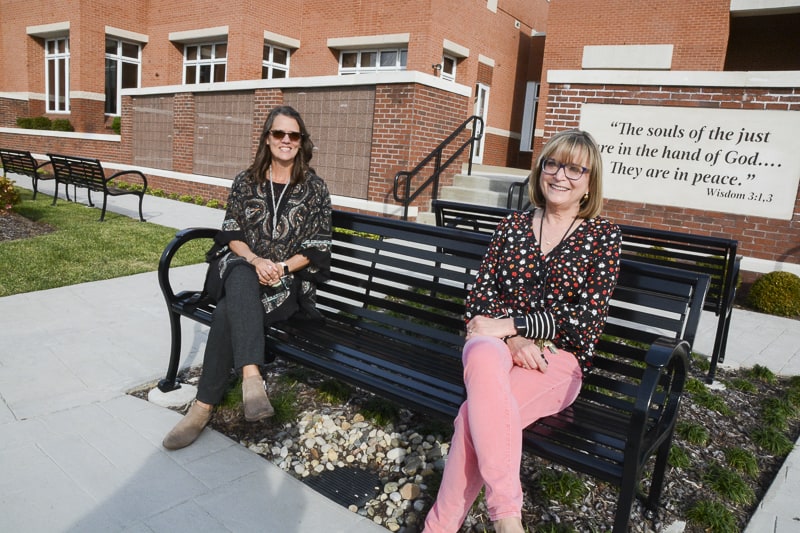
For its parishioners, Holy Family Church in Brentwood is their spiritual home. And it now can be their final resting place.
Earlier this year, the parish completed construction of a columbarium, which is built with niches that can hold cremated remains. The columbarium, which was dedicated by Bishop J. Mark Spalding in June, is located in the parish’s new Prayer Garden.
Since the earliest days of the parish, which was founded in 1989, “there’s been a desire for a columbarium here,” said Betty Lou Burnett, the director of pastoral care at Holy Family.
Many of Holy Family’s parishioners have moved to Brentwood and Williamson County from other parts of the country, have raised their families here, and made a new home here, said Mimi Buettner, a member of the parish staff at Holy Family. “We develop roots here at Holy Family.”
“From Brentwood, Calvary Cemetery is a long way away,” Burnett said of the 152-year-old cemetery owned and operated by the Diocese of Nashville and located on Lebanon Road in Nashville. “People just want another option.”
So the parish approached Bishop Spalding to seek permission to explore the possibility of building a columbarium at the parish, which he granted.
There were a few parameters as the parish began studying the possibility of building a columbarium. First, it had to pay for itself with no parish funds used to build or maintain it, and the bishop directed that it would only be available to current and past Holy Family parishioners and their immediate family.
The parish set about explaining the project to parishioners and gauging their interest. One of the obstacles was explaining to people that cremation is now accepted by the Catholic Church.
Since its earliest days, the Church has taught that our body and soul, separated at death, will be reunited on the day of resurrection of the dead. For centuries, the Church taught cremation was wrong because it was a sign of denial of the belief in the reunification of body and soul.
With the Second Vatican Council, the Church began to rethink its teaching about cremation and now allows it. But it still requires that the body be treated with dignity. Cremated remains are not to be spread into the open or split and kept at people’s homes. The remains should be buried or kept in a columbarium.
The parish conducted a survey and distributed information after Masses. “It was hard to visualize at first,” Buettner said. But interest started to grow.
Before construction could start, the parish needed to sell 280 niches in the columbarium to raise enough money to fund construction. By the deadline, the parish had sold 289, Buettner said.
The Prayer Garden was built on the south side of the building at Holy Family and includes the columbarium, a Memorial Wall for parishioners and their immediate family, a Military Memorial Wall for veterans, and an outdoor altar.
The columbarium has 528 niches, which can hold two urns each, said Buettner, who with Burnett is a member of the parish’s Columbarium Board, which oversees management of the columbarium. The parish has sold 319 niches so far and the remains of 23 people have been entombed in the columbarium.
There is room in the Prayer Garden to expand the columbarium in the future if needed, Burnett said.
Calvary Cemetery also has a columbarium for the entombment of cremated remains, and recently purchased two more, which will add 96 more niches, said Deacon Mike Wilkins, executive director of Calvary. That will bring the total number of niches at Calvary to 468, with just under 200 still available, he said.
There is growing interest in cremation. “When I started, cremation burials amounted to a little less than 25 percent of burials. They are now more than 30 percent of burials. For people who are preplanning, that’s over 50 percent,” Deacon Wilkins said. For non-Catholic cemeteries, “their preplanning numbers are about 65 percent of cremation burials going forward,”
A cremation is less than a third of the cost of a traditional burial, Deacon Wilkins said. “Money seems to be what’s driving the bus.”
The growing interest in cremation could extend the life of Calvary, Deacon Wilkins said. “When the cemetery was originally designed, they were thinking of about 40,000 spaces,” he said. “I’m sure that we will do more than 50,000 before it’s all said and done at this point. That could be a quite bit different depending on how the business changes in the coming decades.”
Besides cremation burials, Calvary also offers traditional burials in the ground and entombment in a mausoleum.
The Columbarium and Prayer Garden at Holy Family make it easy for parishioners to spend time with the remains of their loved ones, Buettner said.
The garden also has an altar and behind the altar is a bronze relief showing the 15th Station of the Cross, the Resurrection of Jesus. The design is the same as the 15th Station in the daily chapel at the residence of Pope Francis, Casa Santa Marta. The relief was made by the Art Studio Demetz in Italy.
The parish celebrated an outdoor Mass in the Prayer Garden on All Souls Day, Burnett said. “It was very profound.”
Parishioners are pleased with the Columbarium and Prayer Garden, Buettner said. “They absolutely love it.”









